Mini Trampoline: The Best Rebounders for Safe Cardio at Home
Mini Trampoline - Boost cardio, balance, and fun at home. Discover benefits, safe exercises, and the best rebounders for every fitness level.
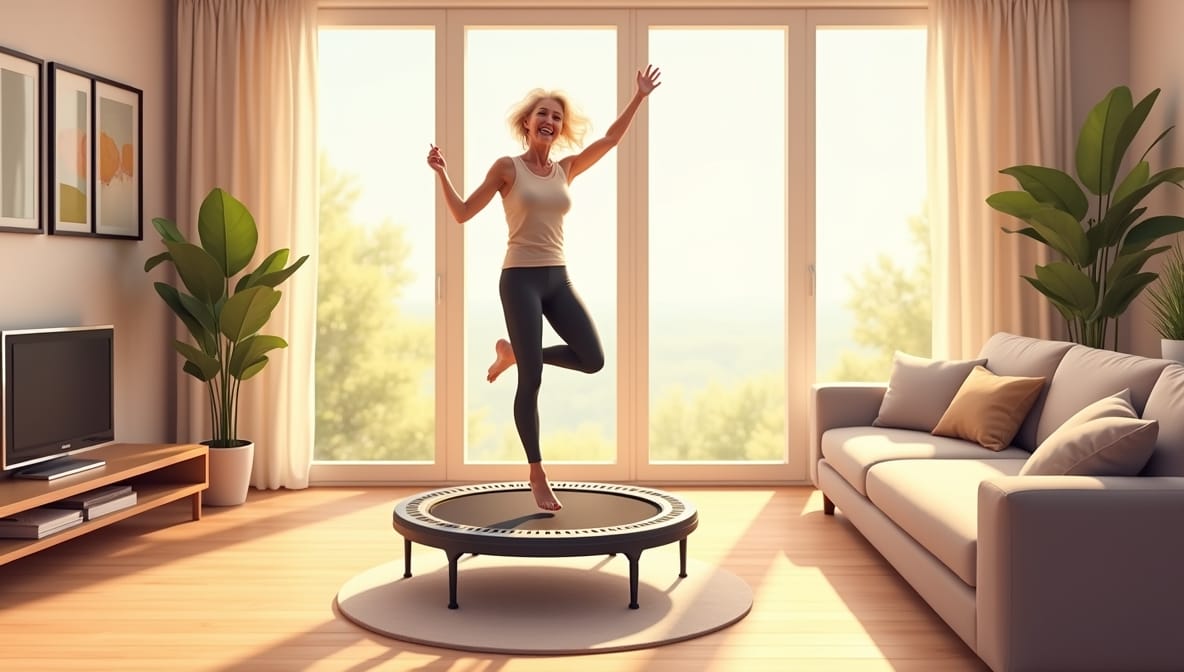
Mini trampolines — often called rebounders — are compact, low-impact fitness tools that let you get a cardio and balance workout in a small space. They’re popular for home gyms, seniors’ balance training, and quick HIIT or low-impact cardio sessions. The mini trampoline market has grown with home-fitness demand: industry reports estimate the global trampoline market at hundreds of millions USD (mini-trampoline segment ~USD 150M in 2024) and continued growth as people keep buying compact home equipment.
Quick stats & why rebounders are trending
- The broader trampoline/rebounder market is expanding year-on-year alongside home-fitness equipment growth. Market analysts project steady CAGR through the late 2020s.
- Rebounding is promoted as low-impact cardio that is easier on joints than running and effective for balance and lymphatic stimulation — a point echoed by fitness experts and rebound-specific resources. Some older NASA research and more recent analyses suggest rebounding can be highly efficient aerobic work for oxygen uptake compared with running. (Interpret with caution — modern studies vary.)
Benefits of using a mini trampoline (what research & experts say)
- Low-impact cardio: provides aerobic stimulus with less pounding on knees/hips than road running.
- Balance & proprioception: ideal for improving stability, useful for older adults and rehab contexts when used safely.
- Lymphatic circulation & recovery: the up-and-down motion assists lymph flow and may help recovery and feeling “less sluggish.”
- Fun + adherence: people stick with enjoyable workouts — rebounders score high on “fun factor,” improving adherence.
Mini Trampoline
Safe Exercises For the Elderly at Home
Here are some of the safe exercises that help improve balance, circulation, and mobility without straining joints:
1. Health Bounce (Gentle Bounce)
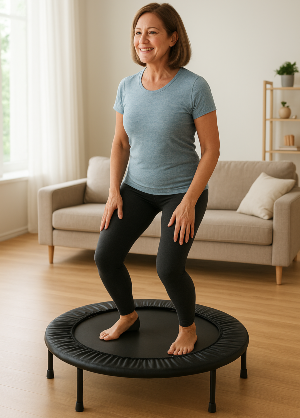
- How to do it: Stand with feet shoulder-width apart, knees slightly bent. Gently bounce up and down without your feet leaving the trampoline surface.
- Benefits: Stimulates circulation, strengthens legs, and supports joint health.
2. Heel Lifts
- How to do it: While standing tall, slowly lift one heel at a time, alternating left and right. Hold onto a stability bar if needed.
- Benefits: Improves ankle strength and balance.
3. Side-to-Side Steps
- How to do it: Step lightly side to side across the trampoline, keeping movements small and controlled.
- Benefits: Enhances coordination and lateral stability.
4. Seated Bounce
- How to do it: Sit safely on the trampoline with feet flat on the floor and bounce gently by pressing into the surface.
- Benefits: Great for core engagement and circulation with minimal impact.
5. Marching in Place
- How to do it: Lift one knee at a time as if marching, keeping a slow and steady rhythm.
- Benefits: Builds endurance, strengthens hips, and supports mobility.
✅ Safety Tips for Seniors:
- Always use a trampoline with a stability bar or near a sturdy surface.
- Keep movements slow and controlled.
- Wear supportive shoes or non-slip socks.
- Start with 2–3 minutes and gradually increase.
- Consult a doctor before starting if there are health concerns.
Buyer’s Guide
How to choose the best mini trampoline (what to compare)
- Frame & construction (safety + durability)
- Look for steel frames (powder-coated) and secure legs (arced/arched legs resist tipping). Higher-quality frames last longer and feel more stable. JumpSport is often noted for sturdier frames.
- Bounce system: springs vs bungees/elastic bands
- Springs provide a snappier bounce, often with more power. Bungee/elastic systems are quieter and gentler on joints — many high-end rebounders use bungees for smoother, quieter rebounds. Check manufacturer info and reviews.
- Weight capacity
- Ensure the rebounder supports your weight plus any dynamic forces. Many adult-oriented rebounders advertise 300–550 lb limits. Higher capacity generally indicates a sturdier design.
- Mat size (diameter)
- Common sizes: ~36–50 inches. Larger mats provide more room and a more comfortable bounce for taller users; smaller sizes are more space-efficient.
- Handlebar
- Removable or adjustable handlebars are great for beginners, seniors, and balance work. If you’re doing higher-intensity workouts, you may prefer no bar, but many buyers like the safety bar for confidence and variety.
- Portability & storage
- Foldable designs or detachable legs help with small apartments. Check folded dimensions and weight.
- Noise level
- Bungee models are quieter than spring models. If you live in an apartment, prioritize quiet rebounders or ones that advertise silent bounce.
- Warranty & support
- Longer warranties and easy access to replacement parts (mats, bungees, springs) are signs of a reputable brand.
- Price & use case
- Premium: durable, adjustable tension, professional features (for frequent high-intensity use).
- Mid-range: solid for regular home workouts.
- Budget: ok for casual users, but check reviews on durability.
Top Picks
JumpSport 350 PRO (approx. 39")
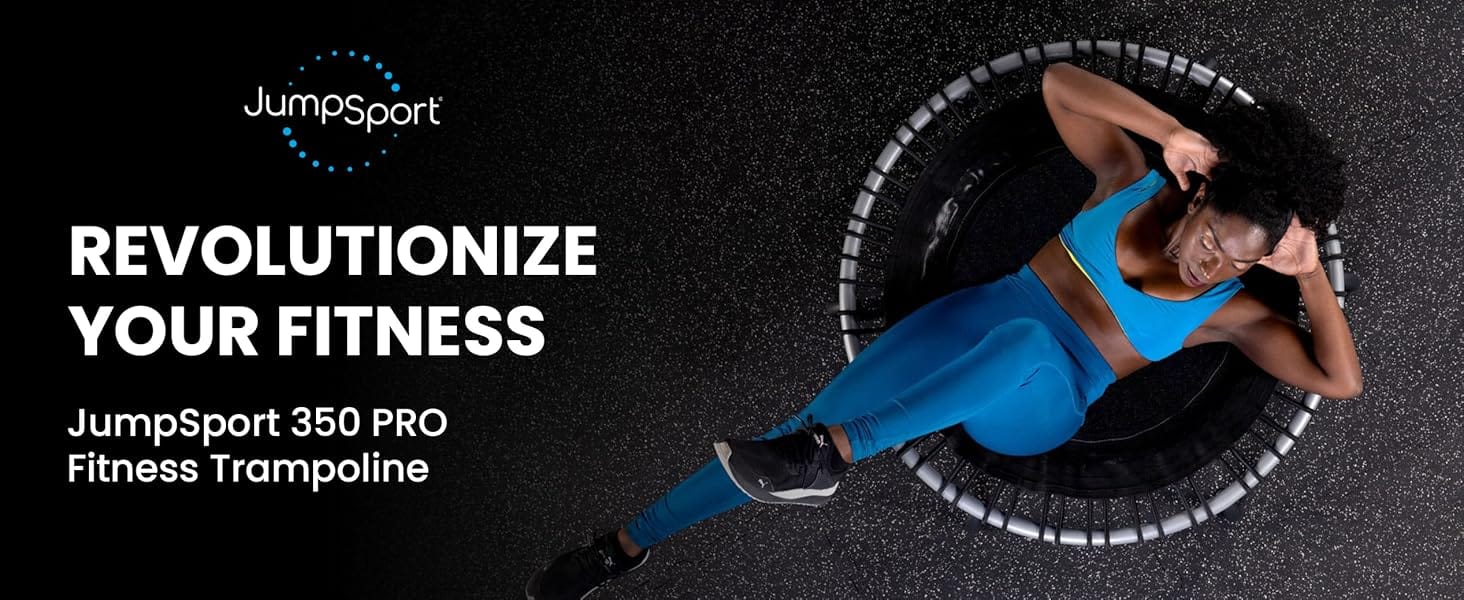
Our rating: ⭐️⭐️⭐️⭐️⭐️ (4.6/5) — sturdy arched legs, adjustable tension, low-noise mat.
Pros
- Adjustable tension (tailor the bounce intensity).
- Solid frame and arched legs resist tipping.
- Quiet, comfortable rebound — gym/pro use capable.
Cons - Pricier than mass-market rebounders.
- Heavier — less foldable/portable.
ANCHEER 50" Rebounder Trampoline
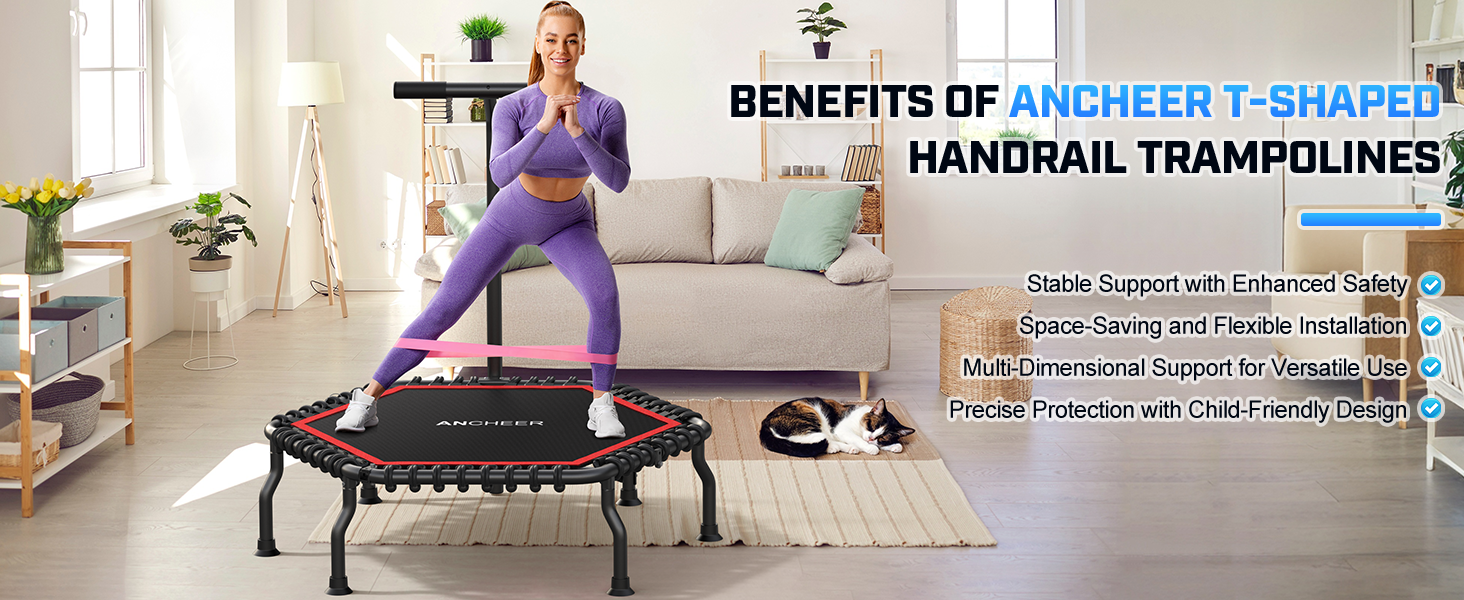
Our rating: ⭐️⭐️⭐️⭐☆ (4.3/5) — larger surface, high weight capacity, foldable design. Great for bigger kids & adults, fitness enthusiasts & jumpers with high-impact needs.
Pros
- Large mat for comfortable movement; often high weight rating (400–550 lbs options).
- The Bungee system is advertised as quiet and joint-friendly.
- Often foldable for storage.
Cons - Size may be too big for very small spaces.
- Assembly sometimes takes longer; mixed reviews on long-term durability.
BCAN Foldable Mini Trampoline (40"/48")
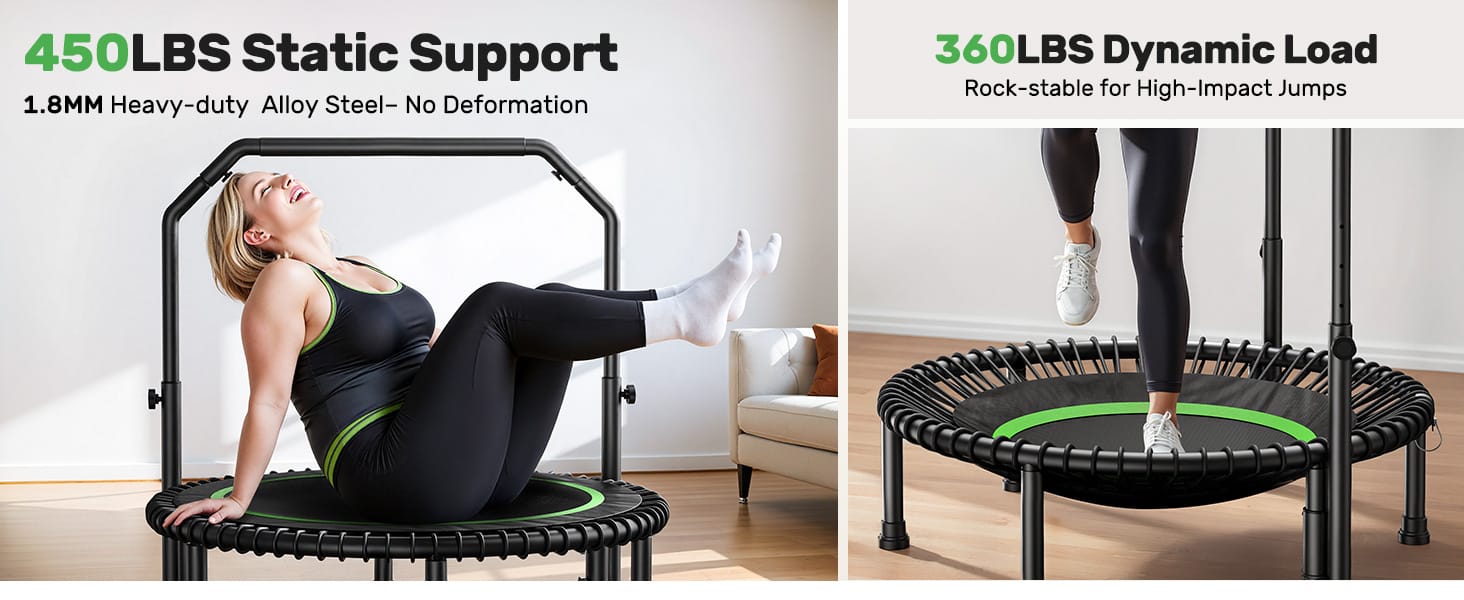
Our rating: ⭐️⭐️⭐️⭐☆ (4/5)
Pros
- Strong value; common in best-seller lists.
- Adjustable foam handlebars are on many listings.
- Foldable models are easy to store.
Cons - Quality control is variable across batches; check recent reviews.
- Some users report squeaking over time.
Stamina 36-inch Folding Trampoline

Our rating: ⭐️⭐️⭐️⭐☆ (4.0/5) — well-known brand for folding rebounders and entry-level fitness gear.
Pros
- Compact, very portable, and easy to store.
- Budget-friendly, simple design.
Cons
- Smaller mat — less comfortable for taller users or high-intensity moves.
- Springs (not bungee) — slightly noisier.
SereneLife 40" Foldable Mini Trampoline
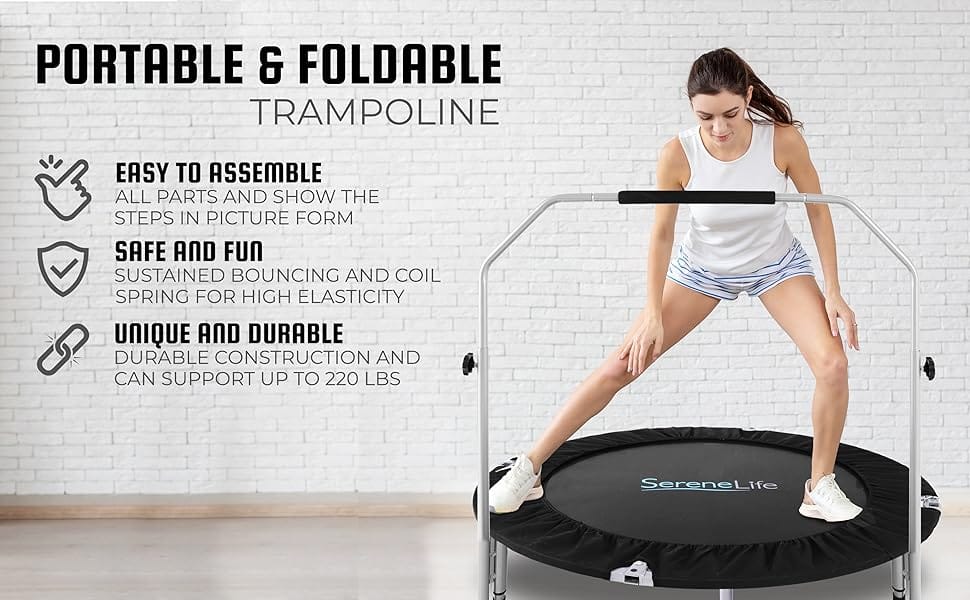
Our rating: ⭐️⭐️⭐️☆ (3.9/5) — common in the budget segment; offers adjustable handlebars and foldable convenience.
Pros
- Affordable, available from multiple sellers.
- Adjustable handlebars and quick fold.
Cons
- Lighter build; may not be as durable long term.
- Not as quiet as bungee-based systems.
FAQs
1. Can you lose weight with a mini trampoline?
A: Yes, you can definitely lose weight with a mini trampoline, and it’s actually one of the most fun and joint-friendly ways to do it. Jumping on a mini trampoline (often called “rebounding”) combines cardio, strength training, and balance work in one workout.
Here’s why it works for weight loss:
- Burns calories effectively – A NASA study found that 10 minutes of bouncing on a mini trampoline can burn as many calories as a 30-minute run. That makes it time-efficient for people with busy schedules.
- Low impact on joints – Unlike running on hard surfaces, the trampoline mat absorbs much of the shock. This reduces the risk of injury while still giving you an intense workout.
- Boosts metabolism – Regular rebounding improves circulation, helps regulate blood sugar, and keeps your metabolism active even after the workout.
- Engages the whole body – Your legs, core, arms, and even stabilizing muscles are constantly at work, which helps tone muscles and support fat loss.
- Fun and sustainable – Since it feels more like play than a workout, people are more likely to stick with it long-term compared to traditional exercise.
Of course, like any fitness routine, weight loss depends on consistency and pairing exercise with a healthy diet. Aim for at least 20–30 minutes of rebounding, 3–5 times a week, to see noticeable results.
👉 Bottom line: Yes, mini trampolines are an effective tool for weight loss. They’re safe, fun, and surprisingly efficient, making them a great option for people of all fitness levels.
2. How long should I use a rebounder each day?
A: When it comes to using a rebounder (mini trampoline), the ideal duration really depends on your fitness level and goals. For most people, starting with 10–15 minutes a day is a safe and effective way to build consistency without overdoing it. As your stamina improves, you can gradually increase your sessions to 20–30 minutes daily, which is generally enough to support weight loss, cardiovascular health, and lymphatic circulation.
If you’re using a rebounder for low-impact exercise or stress relief, even a few 5-minute sessions spread throughout the day can make a noticeable difference. On the other hand, if you’re aiming for higher-intensity workouts, 30 minutes of structured routines (like interval bouncing or strength movements) 3–5 times a week can be highly effective.
The key is listening to your body—you should feel energized after rebounding, not exhausted. Beginners should always start slow, and people with medical conditions (such as joint issues, heart concerns, or balance problems) should check with their healthcare provider before increasing workout duration.
✅ Quick guideline:
- Beginners: 10–15 min/day
- Intermediate: 20–30 min/day
- Advanced/fitness goals: up to 40 min in structured workouts, 3–5 times a week
3. Are rebounders safe for seniors?
Yes, rebounders (mini trampolines) can be safe for seniors — and in many cases, they’re actually recommended as a low-impact exercise option. The gentle bouncing motion reduces stress on the joints compared to walking or jogging on hard surfaces, making it easier on the knees, hips, and ankles.
That said, safety depends on a few factors:
- Balance support: Seniors with balance concerns should choose a rebounder with a stability bar or handle. This adds extra support and reduces the risk of falling.
- Surface quality: Look for models with non-slip mats and sturdy frames that won’t tip over.
- Medical conditions: If a senior has osteoporosis, vertigo, or other conditions affecting balance, it’s important to consult a doctor first.
- Start slow: Beginning with light, gentle bounces is the safest way to build strength, stability, and confidence.
In fact, studies have shown that regular rebounding can improve bone density, circulation, lymphatic drainage, and overall balance — all of which are especially beneficial for older adults.
So, while not every senior will be suited for it, with the right rebounder and safety measures in place, mini trampoline workouts can be a fun, safe, and effective exercise option for seniors.
4. Which is better: spring or bungee rebounder?
to be replacedBoth spring and bungee rebounders (mini trampolines) have their strengths, and the better option really depends on what you’re looking for.
🔹 Spring Rebounders
- Pros: They’re usually more affordable, easier to find, and offer a firmer bounce. Many people prefer them for higher-intensity workouts because the stiffer resistance makes the bounce quicker and more controlled.
- Cons: They can be noisier due to the springs, and the impact on your joints is slightly higher compared to bungee models. Over time, springs may need replacement or lubrication.
🔹 Bungee Rebounders
- Pros: Known for their smoother, quieter bounce. The cords absorb more shock, making them gentler on the joints — great if you have knee or back concerns. They also tend to feel more “fun” and fluid, which many users enjoy for longer workouts.
- Cons: They’re usually more expensive, and the softer bounce may feel less intense for those who want a more vigorous, cardio-heavy workout. Bungee cords can also stretch out over time and need to be replaced.
👉 Which is better?
- If you want joint-friendly, quieter workouts and don’t mind paying a bit more, go with a bungee rebounder.
- If you prefer a firmer, more intense bounce for cardio or plyometric training and want a budget-friendly option, a spring rebounder may be the better choice.
In short:
- Bungee = Comfort & Smoothness
- Spring = Intensity & Affordability
5. What exercises can I do on a mini trampoline?
A mini trampoline (also called a rebounder) is a fantastic piece of equipment because it’s low-impact, joint-friendly, and surprisingly versatile. You can do much more than just bounce up and down! Here are some of the best exercises you can try:
- Basic Bounce (Health Bounce) – Simply bounce lightly without your feet leaving the mat. It improves circulation, warms up your body, and is perfect for beginners.
- Jumping Jacks – Just like regular jumping jacks, but softer on your joints. This boosts your heart rate and works your arms, legs, and core.
- High Knees – Jog in place on the trampoline, driving your knees toward your chest. This is excellent for cardio, balance, and core activation.
- Twist Bounce – Keep your feet together and twist your lower body side to side while swinging your arms in the opposite direction. This move strengthens your obliques and improves coordination.
- Squat Jumps – Lower into a squat, then push off into a controlled jump. The trampoline cushions your landing while still giving you a great lower-body burn.
- Side-to-Side Hops – Hop from one side of the trampoline to the other. This exercise builds agility and strengthens stabilizer muscles.
- Cool-Down Bounce – End your session with a gentle, slow bounce to bring your heart rate down.
👉 Pro Tip: Start with 10–15 minutes a day and gradually increase. Research shows that just 20 minutes of rebounding can burn as many calories as running, without the stress on your knees.
Mini trampolines make workouts fun, easy on the body, and surprisingly effective for cardio, strength, and balance.
Quick safety checklist before you bounce
- Clear the area around the rebounder (length).
- Use a handlebar if balance is uncertain.
- Start slow — use short sessions and build time.
- Wear supportive trainers; avoid bare feet if you want extra mat grip.
- Avoid complex flips or risky moves on compact rebounders.
Key takeaway
Mini trampolines (rebounders) are a fun, space-efficient, low-impact way to add cardio and balance training at home. For most users, a mid-range model with a bungee system and handlebars (if needed) offers the best blend of comfort, quiet operation, and durability. Choose the size and features that match your space, weight, and workout goals; prioritize reputable brands (JumpSport, ANCHEER, BCAN, Stamina, SereneLife) and read recent user reviews for quality control feedback.
